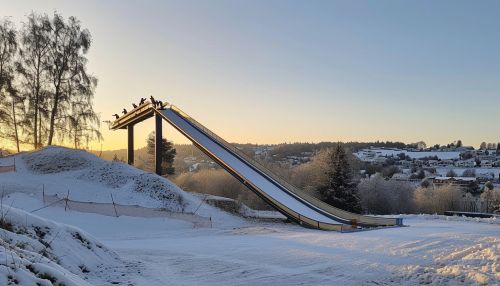Ski Jumping Ramp
Introduction
Ski jumping ramps, also known as ski jumps, are specifically designed structures that allow ski jumpers to achieve maximum distance while maintaining safety. These ramps, which are a crucial part of the sport of ski jumping, are meticulously designed and constructed to meet stringent international standards.
Design and Construction
The design and construction of a ski jumping ramp is a complex process that requires a deep understanding of physics, engineering, and the sport of ski jumping itself. The ramp, also known as the in-run, is where the jumper gains speed before launching into the air. It is typically made of a steel framework, covered with ceramic tiles or porcelain in the summer, and ice in the winter. The angle of the in-run varies between 35 to 37 degrees, which allows the jumper to gather the maximum speed possible before the jump.


The take-off, also known as the table, is the point at which the jumper leaves the in-run and begins the flight phase. It is designed to be a smooth transition from the in-run, with an angle of about 10 to 12 degrees. The design of the take-off is critical, as it greatly affects the trajectory and distance of the jump.
The landing area, also known as the out-run, is where the jumper lands after the flight. It is designed with a downward slope that matches the jumper's trajectory, allowing for a safe and smooth landing. The angle of the out-run gradually decreases from 35 degrees to flat, which helps to reduce the impact of the landing.
Safety Measures
Safety is a paramount concern in the design and construction of ski jumping ramps. The International Ski Federation (FIS) has set strict standards and regulations to ensure the safety of the jumpers. These include specifications for the design of the in-run, take-off, and out-run, as well as the use of safety equipment such as helmets and suits.
In addition to the physical design of the ramp, there are also safety measures in place during the operation of a ski jumping event. These include the use of wind nets to reduce the effect of crosswinds, and the monitoring of weather conditions to ensure they are safe for jumping.
Notable Ski Jumping Ramps
There are many notable ski jumping ramps around the world, each with its own unique characteristics and history. Some of the most famous include the Holmenkollen in Norway, the Bergisel in Austria, and the Planica in Slovenia. These ramps have hosted numerous international competitions, including the Winter Olympics and the World Ski Championships.
Future Developments
As the sport of ski jumping continues to evolve, so too does the design and construction of ski jumping ramps. Advances in technology and engineering are leading to the development of more sophisticated and safer ramps. For example, some ramps are now being designed with adjustable in-runs and take-offs, which can be modified to suit the conditions and the level of the competitors.
